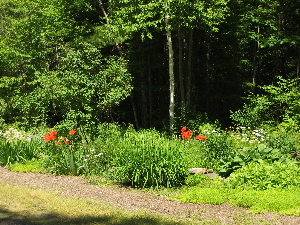FEBRUARY Bring home some wonderful blooming flowers to enjoy around the house!
Look around the garden (if it isn't covered by snow) and be sure none of your perennials have been heaved out of the ground by frost. If they have, press them back down.
Remove any heavy snow from the evergreens.
This is the time to get out and take a good look at your
trees to see if they could stand some
pruning. It is easy to see whether there are
broken or diseased branches now that there are no leaves.
Are you ordering from those catalogs? This is the time to plan on making your dreams come true! At least in the garden.
As you look around the neighborhood, make note of plants that have
"winter interest". Find out what they are and plan to add them to your garden when the weather is better!
Trees are easy to identify in the winter because all the leaves are gone. However, you have no leaves to use to help you either...so go to the book store and buy a
Winter Tree Identification Guide. It's kind of fun identifying trees by their shapes, and the kids love doing it as well.
If you haven't done it already, sharpen those
tools-and while you're at it, organize them as well.
Before you know it, it will be time to roll out the
lawn mower. Has it been serviced? Get it to the shop before everyone else beats you to it.
If you have
grapes, prune the vines now. If you wait until it begins to warm up, they will "bleed".
Force some of your spring blooming twigs for indoor color. Try fruit trees, forsythia, dogwood, pussy willow and quince. Just bring them inside and allow them to sit in a large vase with water.
Keep those bird feeders full.













